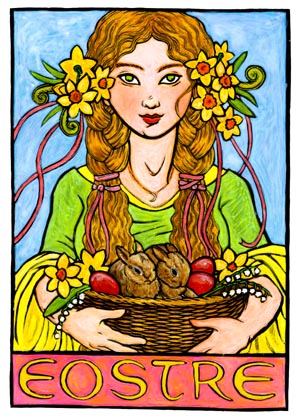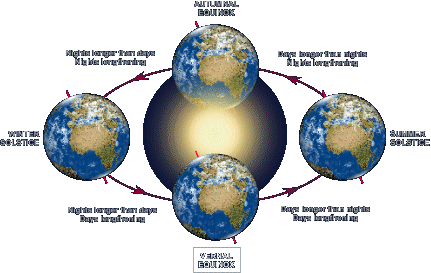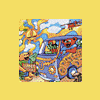Happy Vernal Equinox!
Well tonight just after midnight (seven minutes after) it's the Vernal Equinox or Ostara/Eostre/Ladys Day.

The earth awakens... new life emerges, sap rises, buds shoot and spring flowers are celebrated as gifts from nature. Spring returns and rejuvenates our own life force. Wear Green!

The equinoxes
At the times when the Sun is crossing the celestial equator day and night are of nearly equal length at all latitudes and so we call these dates the equinoxes. In March, as the Sun is moving northwards along the ecliptic, this is called the vernal equinox and in September as the Sun is moving southwards we refer to it as the autumnal equinox. The equinoxes are also the points on the celestial sphere where the ecliptic and equator cross and the vernal equinox is used as the zero point in measuring star co-ordinates.
Vernal comes originally from the Latin word for 'bloom' - it refers to the fact that, in the northern hemisphere, this equinox marks the end of winter and the beginning of spring. Stepping out from the darkness into the light.
However we soon have one of the four Quarter Days in the Legal Calendar it's called Lady Day (March 25). Midsummer Day on June 24 (each year) is the most well known of these. The other Quarter Days are Michaelmas (29 September) and Christmas Day (25 December).

The Astrological and Cultural Significance of the Vernal Equinox
Throughout the history of mankind, the Vernal Equinox has been a time of celebration for many civilisations. For some, it signified the passing of the old year and the rebirth of the new and has, for a long time, been considered the beginning of the Pagan New Year, when the Sun reaches the First Point of Aries (2,500 years ago this was at the Cardinal, Fire Sign of Aries, the Ram).
It was a celebration of the return of the Sun God from the winter underworld. The Lupercalian fertility festival also took place during the Vernal Equinox. Likewise, Easter - originating from the ancient Germanic fertility festival Ostara in honour of the goddess of spring, Eostre, but is nowadays all about fluffy bunnies and painted eggs - celebrations take place on the first Sunday following the full moon that occurs on or following the Vernal Equinox, when the barrenness of Winter is overcome by the fertility that comes with Spring.
What's the Deal With the Egg-Balancing?Crazy Yank idea
According to legend, an egg will only balance on its end on the Vernal Equinox - hence all the people trying to stand their eggs on flat surfaces on this particular day, most of them making scrambled eggs of their effort. The origins of this legend can be traced to ancient China, where it was believed that the balancing of eggs is easily accomplished on 'Li Chun', which is considered to be the 'Beginning of Spring', and which marks the beginning of the Chinese Solar Calendar.
Note that 'Li Chun' is not the Vernal Equinox. It is the beginning of spring, and the Vernal Equinox ('Chun Fen') occurs midway between 'Li Chun' and 'Li Shia', the beginning of summer.
Egg Balancing (for the kids):
Every year, on one particular day in early spring, you will witness a very strange spectacle indeed: people kneeling on pavements, people at tables and desks and counters, all trying to balance an egg on its end. Perhaps, if you are lucky, you may even come across a news article or a special television broadcast featuring masses of people sweltering in the hot sun as they attempt to up-end their eggs.
This is the day of the Vernal Equinox, the day of equal darkness and light. And more importantly, the only day you can balance an egg on its end. Well, supposedly.
Core (Persphone)
Core is the original name of the maiden of the spring, who is the daughter of Zeus and Demeter. Zeus once promised Core to his brother, Hades, without telling her mother. After Hades kidnapped her, she was known as Persephone, Queen of the Dead. Core was enticed by a bloom of narcissus and strayed too far from her companions. In is chariot pulled by coal-black horses, Hades rose up through a chasm in the earth, grabbed her by the wrist, and sat her next to him. Her mother, Demeter, wandered the earth for a very long time looking for her daughter until she came to the sun, and he told her what happened. Demeter then went to Zeus who declared that Persephone be returned to her mother - only if she hadn't tasted the food of the dead. But she had eaten some pomegrante seeds, so she could only return to her mother for two thirds of the year and spent the other third at Hades side as his wife. Although she spent more time as Core, it was only as Persephone that she continued to be in the myths. In one story, Aphrodite asked her to care for a handsome youth named Adonis. This guy was so handsome, in fact, that Persephone refused to return him. As a result of the arguement, Zeus ruled that half the year be spent with Aphrodite and the other half with Persephone. She has a child with Zeus named Zagreus. Persephone's Roman name is Proserpine.
New Year? and Christianity
It used to be considered as the beginning of the Pagan New Year, a time of joy and celebration of the return of the Sun God from the winter underworld.
It has, of course, been incorporated into Christianity. Easter Day is the first Sunday after the first full moon that occurs after the vernal equinox.
At some point before the eighth century AD, the strategians of the early Church superimposed the Resurrection of the Lord on the pre-Christian Eoster-based practice of celebrating spring around the spring equinox. This converted a pagan practice into a Christian one with a simple flick of the theological hand.
Hence the connection between rabbits, eggs and the Lord Jesus, which has puzzled a number of people through the centuries. The answer to the puzzle is disarmingly simple. They were both symbols of Eoster, goddess of rebirth and hence of spring.

"T'was at the Vernal equinox we all joined hand in hand
And we formed a great big circle and we chanted and we sang.
As there's nothing going on just now and no one has a clue
Of what it is we celebrate, but that's what pagans do."
Eoster
The name of Easter in fact derives from the Teutonic and pan-European lunar goddess Eoster, or Ostara, worshipped throughout pre-Christian Europe as a goddess of the rising light, conception and rebirth.
According to myth, Eostre was a playful goddess whose reign over the earth began in the spring when the Sun King journeyed across the sky in his chariot, (in some religions this is drawn by a black horse and white horse) bringing the end of winter. Ostara came down to earth then, appearing as a beautiful maiden with a basket of bright colorful eggs.
Ostara's magical companion was a rabbit who accompanied her as she brought new life to dying plants and flowers by hiding the eggs in the fields.

Both the rabbit and the egg were associated with this goddess of rebirth, for obvious reasons. The rabbit or hare breeds, well, like a rabbit, and from the egg hatches the new life. Both represent the kind of cyclic immortality one finds in nature, where the life of the past year gives birth to the life of the next.
Another Christian observation with pagan roots in this period is the Lady of the Annunciation, on the 25 March, which marks the "verbal" conception of Christ by Mary and the Holy Ghost. Is it coincidence that both the conception and the resurrection of Christ are celebrated in the spring, when the pagan world celebrated birth and resurrection? I think not.
Meanwhile the goddess Eoster lives on as a manifestation of the 'Goddess' of modern pagans and followers of Wicca throughout the world. In the pagan mythology this festival marks the Goddess' conception of the sacred child she began to prepare for on Imbolc and which will be born at the Yule solstice. The festival, though celebrated differently by different groups of pagans, is generally characterised by joyful appreciation of the rebirth of life and anticipation of the coming summer.
The custom of eating hot cross buns is also said to have Pagan origins. The Saxons ate buns that were marked with a cross in honour of Eostre. The ancient Greeks also consumed these types of buns in their celebrations of Artemis, Goddess of the hunt (known as Diana to the Romans). And the Egyptians ate a similar cake in their worship of the Goddess Isis. We eat ours thinking of the circular cross as the symbol of Earth.
Health
This is the time of a major climatic shift which can be quite hard on our bodies as it is, so it is a good time to give a boost to your immune system with natural remedies and cleansing foods.

It was traditional to drink dandelion and burdock cordials at this time as these herbs help to cleanse the blood and are a good tonic for the body after its winter hardships.
As the Vernal Equinox heralds the arrival of spring, it is a time of renewal in both nature and the home, so time for some spring-cleaning! Get your vacuums out!
This is more than just a physical activity, it also helps to remove any old or negative energies accumulated over the dark, heavy winter months preparing the way for the positive growing energy of spring and summer.
As with all the other key festivals of the year, there are both Pagan and Christian associations with the Spring Equinox.
So, as nature starts to sprout the seeds that have been gestating in her belly throughout the winter, maybe you can start to think about what you want to 'sprout' in your life now and start to take action.
Tonight: Tuesday 20th March, 2007, at 7.30pm
Spring Equinox Festival
Glastonbury Goddess Temple

SpringThe figure of a prone woman, as green as the hills, slumbers on the flat land surrounding Glastonbury. Her hip and thighs double as Tor Hill with its famous tower. Her shoulder is Wearyall Hill where Jesus’ uncle Joseph of Aramathea is said to have stuck his staff in the ground, creating the first holy thorn tree. Her belly and breasts rest on the fields.
It is the view from the artist Dorrie-Joy’s garden; the idea for it came as she was cycling really fast back towards her home. "The landscape looked just like that. It is a union between earth and sky".
This Glastonbury Tor Goddess represents peace, rest and balance, within and without. She sleeps beneath the love of the sun and the moon as they meet with equal strength of night and day.’ It is a powerful picture for the Spring Equinox (19th March), both the woman and the land she rises out of being abundant in fertility and readiness to flower.
I used to remember something about two people fighting on a bridge of wood over water with staves one in white and one in black and the white one would win - but i think now perhaps it was green not white - i forget it's been a few years. There's also stuff about Taleisin, slamon, violets, astral projection ,re-incarnation and stuff like that. I've got in my head a great picture of a Celtic chariot and a woman sowing seeds from it - from a Tarot set by Courtney Davies





1 Comment
Recommended Comments